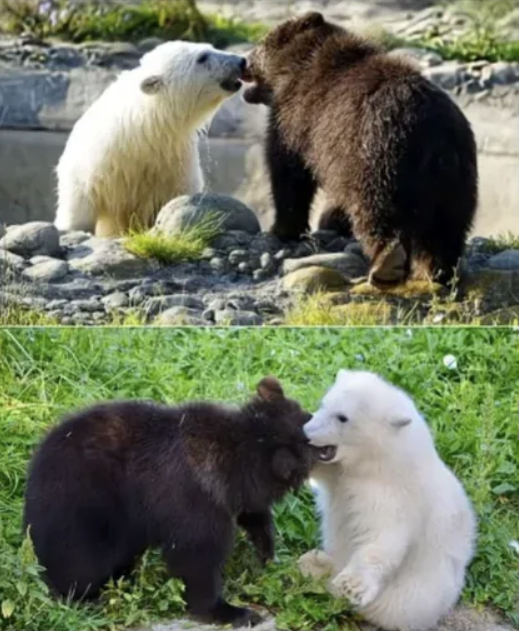
They weren’t supposed to meet. Their stories began in rejection and loss—a tiny polar bear cub pushed away by her mother, and a grizzly bear orphaned in the wild before he could learn to survive on his own. Two lives that should have ended before they really began, saved only by the intervention of humans who brought them to a rescue center where abandoned animals are given second chances.
The polar bear arrived first, so small she could barely stand, her white fur still soft with newborn vulnerability. The grizzly came later, dark and frightened, grieving losses he was too young to understand. The rescue staff did what they always do—provided food, warmth, medical care, all the practical things that keep bodies alive. But they couldn’t provide what these cubs needed most: family.
Then something extraordinary happened. When their paths crossed at the center, something clicked. The polar bear, who should have been wary of another species, approached the grizzly with curiosity instead of fear. The grizzly, who’d known nothing but loneliness, responded not with aggression but with tentative friendship. Within days, they were inseparable—playing together, sleeping side by side, finding comfort in the presence of someone who understood what it meant to be lost.
Their bond defied everything researchers know about bear behavior. Polar bears and grizzlies don’t form friendships in the wild. They occupy different territories, hunt different prey, live entirely separate lives. But these two cubs didn’t know they were supposed to be different. They only knew they’d both been abandoned, both survived against odds, and both found exactly what they needed in each other.
As weeks turned to months, their friendship deepened into something that looked remarkably like family. They learned bravery together—the polar bear teaching her friend about water, the grizzly showing her how to climb and explore. They healed together, too, their shared trauma becoming something lighter when carried between two instead of alone. What started as survival became joy, and what began in loss became love.
The rescue center documented their friendship, sharing photos that traveled worldwide and touched hearts everywhere. People saw in these bears what they recognized in themselves—the universal need for connection, the healing power of companionship, the way love can emerge from the most unexpected places. Two species that weren’t supposed to bond, two cubs that weren’t supposed to survive, proving that family is less about biology and more about who shows up when you need them most.
Their story became a reminder that sometimes the family you need isn’t the one you’re born into but the one you find along the way. That survival isn’t just about food and shelter—it’s about connection, about having someone who sees you and chooses to stay. That the most unlikely friendships can become the strongest bonds, precisely because they weren’t guaranteed or expected but chosen freely.
The polar bear and grizzly will likely spend their lives together at the sanctuary, growing from vulnerable cubs into powerful adults who never forget they saved each other. Visitors will watch them play and rest side by side, marveling at the friendship that shouldn’t exist but does—beautiful, improbable, and absolutely real.
Two cubs who weren’t supposed to survive. Two species that weren’t supposed to bond. One friendship that proved love finds a way, even when the world suggests it’s impossible. Sometimes the family you need is the one you find when everything else has been taken away, and that family—built on shared loss and mutual healing—becomes the strongest thing you’ll ever know.